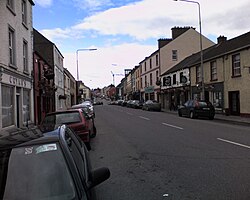Ballinamore
Ballinamore
Béal an Átha Móir | |
|---|---|
Town | |
 Main Street-High Street, Ballinamore | |
| Country | Ireland |
| Province | Connacht |
| County | County Leitrim |
| Elevation | 74 m (243 ft) |
| Population (2011)[1] | |
• Total | 889 |
| Irish Grid Reference | H131112 |
| Website | www |
Ballinamore (historically Bellanamore, from Irish: Béal an Átha Móir, meaning 'mouth of the big ford')[2] is a small town in County Leitrim, Ireland, 19 km (12 mi) from the border with Northern Ireland. It is located on the R202 regional road where it is joined by the R199 and R204. [Béal an Átha Móir] Error: {{Lang}}: text has italic markup (help) means "mouth of the big ford", and the town is so named because it was the main crossing point of the Yellow River, which flows past the town. This waterway become known as the Ballinamore-Ballyconnell canal, built to link the Rivers Erne and Shannon in the 1840s. It reopened as the Shannon–Erne Waterway in 1994.
History
The history of Ballinamore has enabled it to grow through the centuries as a town with a large variety of trades and tradesmen. The first mention was under the plantation of Leitrim in 1621 when the Manor of Ballinamore was granted to Sir Fenton Parsons with 600 acres (2.4 km2) of arable land.[3] In the 18th century, settlers from County Down who were dispossessed by landowners travelled to the west of Ireland looking for new places to live.[citation needed] They stopped in an area of land they found suitable notably for its location near the rivers Shannon and Erne. This was the origins of Ballinamore. These dispossessed people brought with them numerous skills such as blacksmiths, tinsmiths, skilled craftsmen and farmers. Between 1695 and 1750 there was a flourishing ironworks.[3]
Transport
Ballinamore railway station opened on 24 October 1887, but finally closed on 1 April 1959.[4] It was part of the narrow gauge Cavan and Leitrim Railway and was the hub of the line, with the locomotive depot and works. It was the point where the line from Dromod through Mohill and Ballinamore to Belturbet branched to Kiltubrid, Drumshanbo and Arigna.[5]
The Ballinamore and Ballyconnell Canal was opened in 1860 but was not a success and fell into disrepair. It was restored in 1994 as the Shannon-Erne Waterway and now brings more tourists into the town.
Ballinamore has daily Locallink bus services to Carrick on Shannon and Dromod railway station Monday to Saturday.
Notable features
- The local Church of Ireland church is the oldest building in Ballinamore in the 1780s from the ruins of the local Roman Catholic Church (St Patrick's) demolished during the reformation and penal laws.
- The Ballinamore Estate was granted to the Ormsby family in 1677.[6] Elizabethan settlers located at first in County Sligo, from where they spread into Counties Mayo, Roscommon and Galway. The Ballinamore branch were descended from the Ormsby of Comyn or Cummin in county Sligo.
- A monument to the IRA Chief of Staff, TD, and local councillor John Joe McGirl is located on the bridge crossing the Shannon-Erne Waterway. The monument bears the phrase: "An Unbroken and Unbreakable Fenian".
See also
References
- ^ "Population Classified by Area" (PDF). Central Statistics Office (Ireland). Apr 2012. p. 47. Retrieved 25 Oct 2016.
- ^ Placenames Database of Ireland (see archival records)
- ^ a b Fr Dan Gallogly (1991). Sliabh an Iarainn Slopes, History of the Town and Parish of Ballinamore, Co. Leitrim.
- ^ "Ballinamore station" (PDF). Railscot - Irish Railways. Archived from the original (PDF) on 26 September 2007. Retrieved 2007-09-09.
{{cite web}}: Unknown parameter|deadurl=ignored (|url-status=suggested) (help) - ^ Baker, Michael HC (1999). Irish Narrow Gauge Railways. A View from the Past. Ian Allan Publishing. ISBN 0-7110-2680-7.
- ^ "Estate Record: Ormsby (Ballinamore)". Landed Estates Database. NUI Galway. 18 May 2011. Retrieved 5 April 2012.

